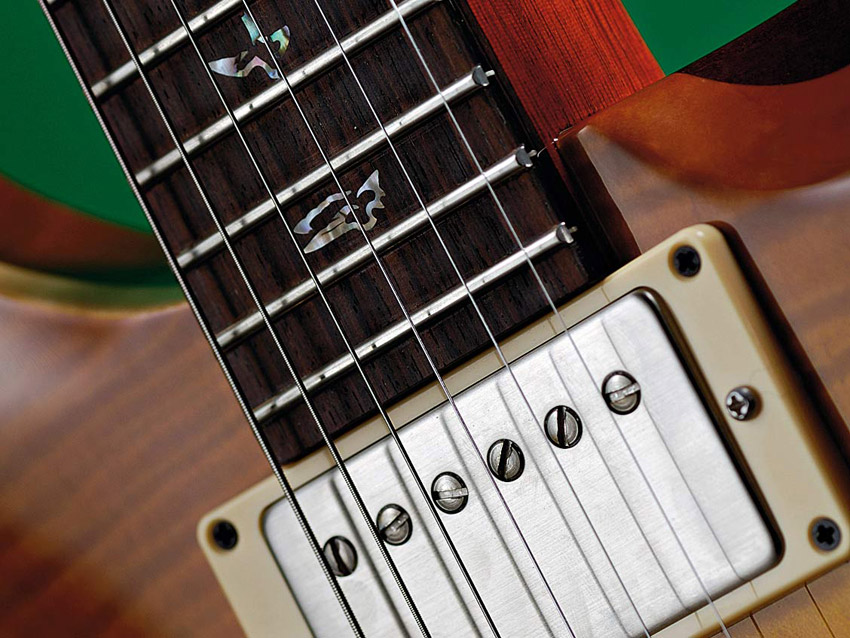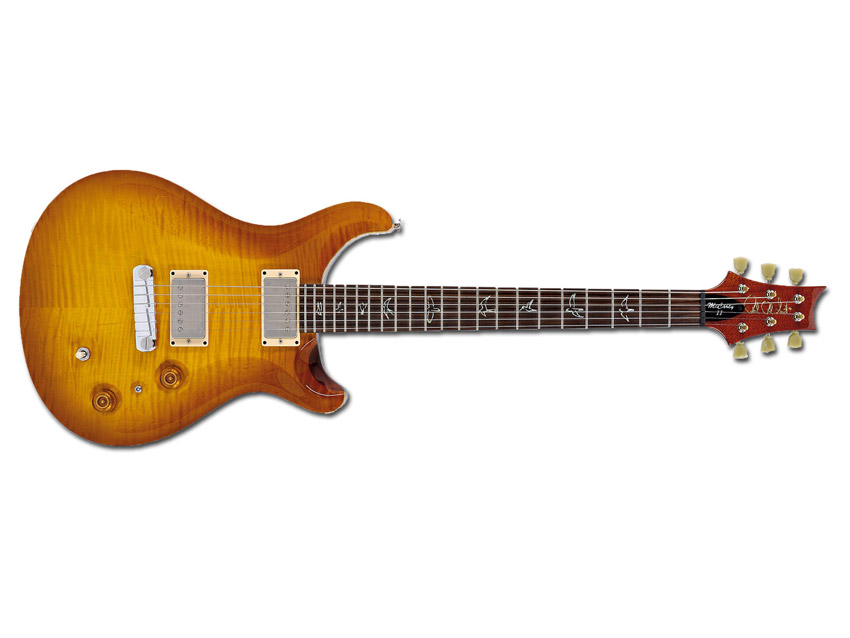MusicRadar Verdict
PRS's most vintage double-cut model is an odd choice for a very modern active circuit. But if you need expanded sounds, try one.
Pros
- +
Slightly vintage spin on classic PRS. Vintage sounds. Expanded MVC tones. Build.
Cons
- -
Short battery life.
MusicRadar's got your back

PRS McCarty II

PRS McCarty II
Here's a new PRS model that brings active electronics to one of the brand's most 'vintage' styled guitars. The McCarty II, when launched in January, saw the end of the original McCarty model, named after Ted McCarty, the late ex-Gibson visionary who became a mentor to Paul Reed Smith.
In reality the McCarty II is very close to the previous model in terms of specification. The body depth is increased and the top is East Coast 'red' maple (as used on many original Les Pauls), which can be plainer in appearance with a few more flecks and streaks.
We also get the new unplated Stop-Tail bridge with brass posts and the vintage-style Kluson tuners (now, like all of PRS's tuners, with unplated brass posts).
Neck profile is limited to the full feeling but far from huge wide-fat. Moon inlays are standard and the only option is the bird inlays with just two 'bursts and black for finishes. Also new to the model are PRS's 245 pickups, here with old-looking, scuffed nickel-plated covers.
Increased options
The major difference is the Mastering Voice Control pot, powered by two nine-volt blocks (with a relatively short battery life of approximately 40 hours).
"Originally, Carlos Santana was looking for more tonal options from his guitar, more in the direction of Stevie Ray Vaughan," explains PRS's J Hayes. "So Paul came up with this active circuit that would give Carlos a '60s single-coil sound but without the hum issues that plague such instruments. The second version that is used in the McCarty II is based on the same concept."
The circuit is engaged by a mini-toggle switch — with the MVC switched out the guitar remains passive and will work even with dead batteries — and the tone control is replaced by a centre-notched pot which moves from the single-coil tones to "heavy metal sounds".
"It's completely variable," said Paul Reed Smith earlier this year, "like a pan pot on a console. And it was designed by a guy who does consoles. I couldn't be more pleased. Watching people's jaws drop has just been a hoot."
Sounds
Here's Guitarist's Simon Bradley with the McCarty II:
Loaded with 245 pickups this McCarty has a little different character to the previous model and also other guitars such as the SC245 and even the Mira (which uses the same 245 pickups but without covers).
There's more maple than the single-cut SC245, plus it's not chambered, slightly weighty and firm in its resonance. The resulting passive sound has a certain firmness to it, slightly less resonant than other PRSes we compared it too, noticeably a '94 Custom 22.
But the McCarty still packs a big punch, there's an edge to the sound that creates clarity at higher gains and the downside of the MVC is that you don't get a tone control to roll off high-end if that's what your set-up and style requires.
It sounds more rock than blues to our ears, but easily nails a classic '70s style tone, the bridge pickup being a little more forceful than we remember of the SC245; less roomy in the lows courtesy of the double-cutaway.
PRS rarely creates a bad neck pickup sound and this has bags of depth, soul and enough clarity to cut successfully through quite a gained amp tone.
Mastering commander
Engaging the MVC does produce some noticeable background hiss. Turning it fully anti-clockwise produces that '60s single-coil sound and, as ever, with a little volume control reduction the sound is certainly accurate with reduced mids and a tighter low-end.
To our ears it's most useful with the mixed and neck positions - the former almost Tele-like in its hollowness, the latter with a little gain boost that sits nicely in Texas-y territory. Turn the MVC the other way and you're primarily hearing an enhanced low-end with slightly scooped mids (Smith believes the high-end to be "more Tele-like" but that's harder to perceive).
It certainly works for bigger 'metal' voices, but it's a little like moving from a small combo to a half-stack, or like a double-cut to a single-cut. To put it another way it's more than just metal and produces a really huge rhythm sound with even just '70s-era amp tones. In short, this is a vastly expanded McCarty.
With the quality of construction and finishing a byword at PRS - to be honest it's getting better - it's no surprise that this guitar is pro-spec'd and ready to go.
PRS's McCarty II does what it says on the tin. Aside from its solid passive performance - a real workhorse guitar for classic rock use - the new active circuit brings both a highly accurate single-coil tone (without the noticeable volume drop of the usual passive coil-splits) and a surprisingly useful 'metal' sound that can certainly be used for older rock rhythm styles too.
But as good as it is, we can't help thinking the MVC should be in a pedal, maybe with a gain boost, which could be mains-powered. That way we wouldn't have to shell out a considerable amount of cash for the guitar (as well as two nine-volt blocks every 40 hours). There are many players who simply wouldn't use active guitars but happily step nightly on active stomp boxes!
Dave Burrluck is one of the world’s most experienced guitar journalists, who started writing back in the '80s for International Musician and Recording World, co-founded The Guitar Magazine and has been the Gear Reviews Editor of Guitarist magazine for the past two decades. Along the way, Dave has been the sole author of The PRS Guitar Book and The Player's Guide to Guitar Maintenance as well as contributing to numerous other books on the electric guitar. Dave is an active gigging and recording musician and still finds time to make, repair and mod guitars, not least for Guitarist’s The Mod Squad.
“We were arguing a lot and we were miserable”: How Green Day exceeded expectations with their most ambitious song
"There’s plenty for us guitarists to learn – and ‘less is more’ is the overriding lesson": how to play like George Harrison on The Beatles' Abbey Road
“They didn’t like Prince’s bikini underwear”: Prince’s support sets for the The Rolling Stones in 1981 are remembered as disastrous, but guitarist Dez Dickerson says that the the crowd reaction wasn’t as bad as people think










